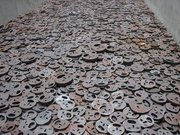Jewish Museum Berlin
|
|
The Jewish Museum Berlin (Jüdisches Museum Berlin) is a museum in Berlin covering two millennia of German Jewish history.
The Jewish Museum in Berlin was originally founded in Oranienburger Strasse in 1933. It was closed in 1938 by the state police. The idea to revive the museum was first voiced in 1971, and an "Association for a Jewish Museum" was founded in 1975. A Jewish department of the Berlin Museum was opened after the Berlin Museum first displayed an exhibition on Jewish history in Berlin in 1978. In 1999 the Jewish Museum Berlin was granted status as an independent institution. A building by Daniel Libeskind was finished in 1998 and officially opened in 2001; the foundation stone for the extension building to the Berlin Museum was laid in November 1992. It has now become a lively center for Jewish history and culture.
Libeskind's design created an open area enclosed by the internal walls of the museum, called the memory void for those affected by the Holocaust. Menashe Kadishman's 'Shalechet' ('Fallen leaves') installation filled this void with 10,000 coarsely made iron faces. Visitors are permitted to walk on the work. Doing so creates an almost 'industrial' noise, something with deep meaning.
The director of the museum is Professor W. Michael Blumenthal, who is originally from Berlin and was US Secretary of the Treasury under President Jimmy Carter.
Further reading
External links
Website of the museum (http://www.jmberlin.de/) de:Jüdisches Museum BerlinTemplate:Museum-stub

